This episode of Light Hearted was originally released on July 10, 2019. You can listen with the player below; the entire transcript follows. This was the second of three “Cape Cod Week” episodes. Jeremy D’Entremont interviews Betsy Richards, president of the Nauset Light Preservation Society, and Hawkins Conrad, who was the group’s first president in its formative days in the 1990s. Co-host Michelle Jewell Shaw and Jeremy discuss more of the early history of the oldest lighthouse on the North American continent, Boston Light in Boston Harbor, including the 1719 fog cannon.
JEREMY
You are listening to Light Hearted, the official podcast of the United States Lighthouse Society. My name is Jeremy D’Entremont.
Welcome to the second of three editions of Light Hearted we’re releasing this week for Cape Cod week. We are once again coming to you from the semi-famous Study Room Three of the Portsmouth Public Library in historic Portsmouth, New Hampshire.
MUSIC
My cohost again today is Michelle Jewell Shaw. How about another fun fact about Cape Cod Michelle?
MICHELLE
No problem. Jeremy, the year round population of Cape Cod, Massachusetts, is about 216,000, but it swells by more than 250% to over 500,000 in the summer.
JEREMY
Wow, that’s right. You don’t want to be caught in Friday afternoon traffic coming onto the Cape or Sunday afternoon traffic leaving the Cape.
MICHELLE
That doesn’t sound like a whole lot of fun to me, either, Jeremy. That’s why year-round residents have “Cape Cod Tunnel” pass stickers on their cars. There’s actually no such thing as the Cape Cod Tunnel. The stickers are an attempt to confuse the tourists.
JEREMY
Yeah, I’m tempted to say tourists are easily confused, but I’ve been a tourist many times in my life so I probably shouldn’t say that. On today’s edition of Light Hearted, we’re going to travel most of the length of Cape Cod to the town of Eastham. The town was originally settled by the Nauset Tribe.
MICHELLE
In 1620, a hunting expedition comprised of some of the crew of the Mayflower, which had stopped in Provincetown Harbor on Cape Cod Bay, had their first meeting with the local Nauset people at First Encounter Beach.
JEREMY
Today, Eastham is known as the gate to the Cape Cod National Seashore. Nauset Lighthouse in Eastham is one of the most popular icons of Cape Cod. When I mention it to people, most lighthouse buffs are familiar with it, but if people don’t know what I’m talking about, I tell them it’s the lighthouse on the Cape Cod potato chip bags. Then they know what I’m talking about.
MICHELLE
It’s funny you say that Jeremy, because whenever I mention that lighthouse, that’s how I describe it as well. Nauset Lighthouse also stands as a symbol of the battle so much of Cape Cod is fighting against coastal erosion. In 1996, the lighthouse had to be moved back about 300 feet from the edge of an eroding cliff to save it from oblivion. Today, Nauset Lighthouse is a private aid to navigation owned by the National Park Service and operated by the Nauset Light Preservation Society.
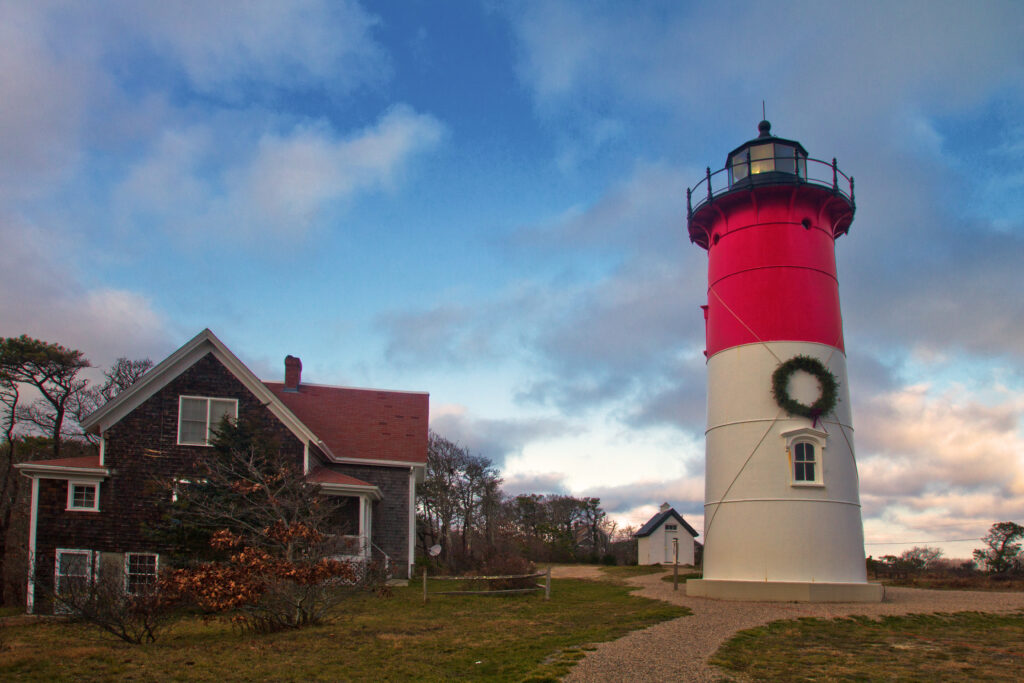
JEREMY
The mission of the Nauset Light Preservation Society is to operate and maintain Nauset Lighthouse, the oil house, and the surrounding property, to interpret the site to the public, and to raise funds through memberships and donations to keep the lighthouse lit. A couple of months ago, I met in Eastham with Betsy Richards and Hawkins Conrad, two very important volunteers for the Nauset Light Preservation Society. Let’s listen to that interview now.
JEREMY
I am here in Eastham on Cape Cod today, and we are at the Eastham United Methodist Church. And I’m here with Betsy Richards, the president of the Nauset Light Preservation Society, and also Hawkins Conrad, who was the organization’s first president. Betsy and Hawk, thank you so much for being with me today. I really appreciate it. I know it’s kind of a long story. We don’t have time to go into all the details—that would take quite a while—but I know that Nauset Lighthouse originally had to be rescued back in 1993, when the Coast Guard announced it was going to be decommissioned. Hawk, you were there at the start along with several other people, including Harold Jennings, who I knew personally. Several people founded the Nauset Light Preservation Society at that time. Could you tell us a little bit of background about how it got started back then?

HAWKINS CONRAD
Well, of course, we had had some rumblings and warnings that the Coast Guard was considering decommissioning the lighthouse. And of course, that meant that they would probably have to deconstruct the lighthouse to keep it from going over the edge. They wouldn’t have allowed that. And they reached a conclusion of course, that it was not cost effective to move the lighthouse and they seemed to be content to spend the amount of money it took to operate it for a while. But when it came — the backs were against the wall when erosion was catching up to the lighthouse. And so they did decide to decommission it. Of course, that has a great impact on the local folks here. It’s just such a landmark, not only to us, but to everybody. That started a sort of a grassroots group to a save to the lighthouse. Harold Jennings, as you said, was very instrumental. And with some of his contacts with lighthouse organizations, in putting together a meeting. And I was invited to the meeting because I was the president of the historical society in Eastham at the time and somehow or other the need to move the lighthouse grew. And I found myself elected president and faced with the job of raising enough money to move the lighthouse.
We got the Coast Guard to let us have weekend open houses and they were very helpful in aiding us in that. So we were running open houses, collecting donations. We opened up a gift shop down in a little boathouse that – actually it was a garage that sat down by the road leading up to the lighthouse, and we were selling all sorts of goods. [?] was very instrumental in making money for us with that gift shop. And so we were continuing and gradually building up money and had a lot of enthusiastic support from the community and just from the tourists that came to see the lighthouse.
But then on January the fourth of 1996, we had a tremendous northeaster. And, in fact, I went up to the lighthouse after the storm and snow [was] whipping up the banks leading up to the lighthouse. It actually packed snow underneath the catwalk of the lighthouse. And so, at the end of the storm, when we looked down at the bottom of the cliff, we could see we had lost about 18 or 20 feet. And we had about 50 feet from the edge at that time. And we knew in a matter of a year or so, that 20 feet was going to translate up to the top of the cliff, as it all slumped out to regain its normal angle of rest.
And so we knew the time was very, very short to get the lighthouse moved. As it turned out, our treasurer, George Abbott, happened to know of a program called ISTEA. And it was a fund that was established to save old railroad stations, historic transportation items. And we figured a lighthouse would certainly qualify in that area. And we got the grant that Massachusetts received from the federal government in the ISTEA program and gave us all the money we needed to move to the lighthouse. And with all the money we had raised at that point it allowed us to renovate the lighthouse after it was moved. So we signed a contract with International Chimney company who had been moving the lighthouses and was in the process of moving the lighthouse at Truro. And when they got through with that, they just moved the crew now to where we were and moved our lighthouse for us.
JEREMY
Yeah. Yours was kind of a piece of cake compared to the one in Truro.
HAWKINS CONRAD
Yes, they called it a piece of cake. I think they estimated about 80 tons and rigged for about a hundred.
JEREMY
I remember that really well, In November ’96, when the lighthouse was moved. I followed the whole thing pretty closely and I actually came the day the move was completed here, of Nauset Lighthouse. Unfortunately, I think it went a little bit smoother and faster than everybody expected. So when I came, I was hoping to see some of the actual process, but it was all finished by the time I got here. So I saw, uh, some of the celebration after it was finished. I remember how happy everybody was. It really was an amazing accomplishment. You must have been so happy when that, when that was all completed.
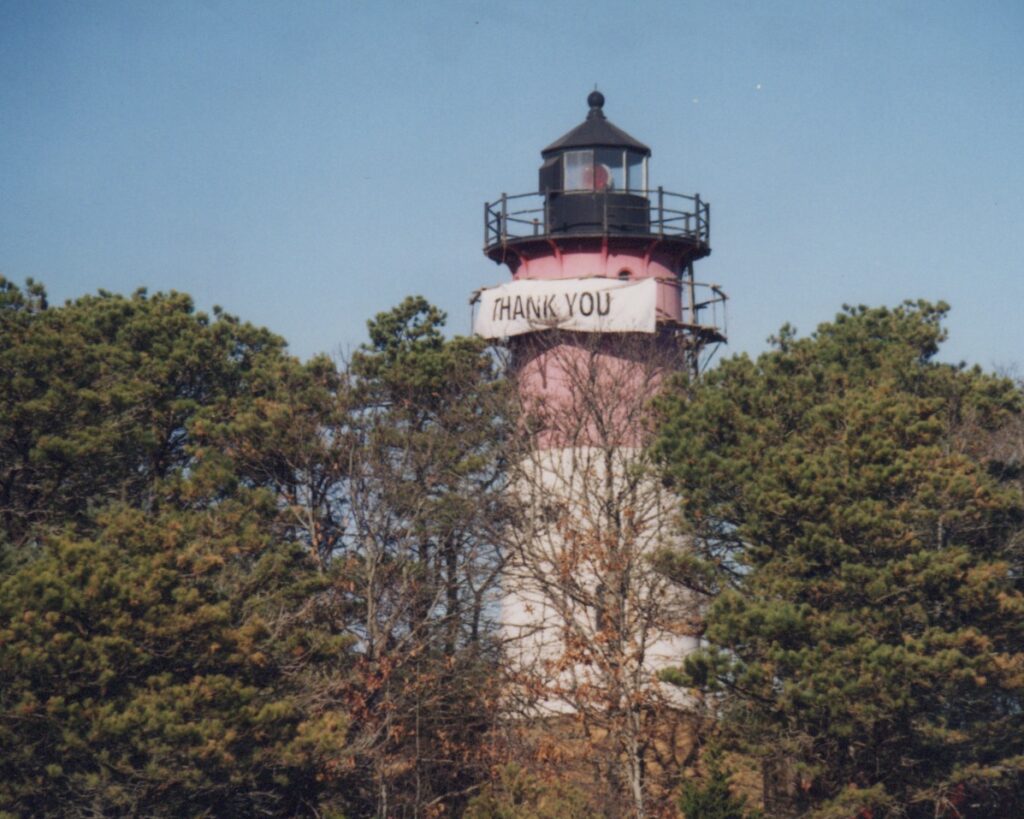
HAWKINS CONRAD
Oh, yes. They just took about one work day to get the whole job done. They started moving at about four o’clock in the afternoon and when it moved, it trembled back and forth quite a bit. Everybody gasped. Then it settled out and they moved it across in front of the keeper’s house and then made a left turn and came down the edge of the lot and stopped at the bottom of the hill, so that they could—the next day they were going to drop the power lines that would have to be crossed.
And so the next morning they dropped the power lines, brought it out on the blacktop road and up to the driveway that they had established, over its new location. And then the most difficult part of the whole thing was they had made a U-turn in the process, of course, of moving the lighthouse. So it had to be turned to 180 degrees around in one place, which involved a whole lot of bulldozers pushing and tugging and bumping up against things. But they did manage to do a 180 degree turn, get it centered, of course, where the new foundation was going to be. And then they held it at the right height while they did brickwork up from the footings up to the foundation of the lighthouse.
JEREMY
Right. I should mention for listeners who might not know, Nauset Lighthouse is a cast-iron lighthouse, and also shorter than some of the other lighthouses that have been moved, including Highland Light or Cape Cod Light in North Truro on Cape Cod, which is a tall brick tower, and Cape Hatteras Lighthouse in North Carolina, which is over 200 feet tall—the tallest lighthouse in the country—was also moved by International Chimney. And Block Island Southeast Light in Rhode Island is a massive brick structure, which they also moved in 1993. So Nauset Lighthouse is a smaller cast-iron tower. So it was not that it was easy or anything like that, but compared to those, those massive brick towers, it was an easier process.
HAWKINS CONRAD
Much easier. And of course, one thing that most people don’t realize is that Nauset Light, as were most of them on Cape Cod, was built for north-south traffic—intercoastal traffic, basically, and built to keep people from running afoul of the sandbars off the shore. And Highland Light, by comparison, also serves as an east-west. It was a transatlantic light that would be raised. So even though it was up on a high bluff to begin with, it was made very tall so it would be seen much further out to sea than Nauset Light is.
JEREMY
True. Yeah. Now erosion continues to be a problem at Nauset Light Beach. How endangered would you say the lighthouse is at this point? And could you take—I know it’s a wild guess—but could you take a guess at how long it might be before the lighthouse will need to be moved again?
HAWKINS CONRAD
Well, we were guessing about 70 years when we moved it. We did have a bit of a squabble with the [Cape Cod National] Seashore who wanted it to move it to an extremely safe location, way back on a hill, far away from the ocean and in the woods. And we said, that’s not a place that you would put a lighthouse. And so we prevailed upon a location. It was just about three or 400 yards back, to the rear. And on a terrain feature that was almost identical to one that it was originally sitting on. And so, we had a meeting with the Seashore and the townspeople and we put up the several options that were being offered and lo and behold, all the townspeople sided with us. And so the Seashore accepted the place that we wanted to move to. And I guess the fact that we were paying the bill also had a good bit to do with it.
JEREMY
Betsy, I’d like to turn to you at this point, there aren’t many lighthouses, really, it’s a pretty small minority of lighthouses in new England that are open on any kind of regular basis. And it’s a great thing. I think it’s really wonderful that Nauset Lighthouse is open pretty often — you have frequent open houses for the public. Can you tell us, Betsy, a little bit about how the open houses work and tell us — I know we’re going to be featuring this interview on our podcast in July, I believe about mid-July, but could you talk a little bit about your general open house schedule this year?
BETSY RICHARDS
Well, we always start our official tours on Mother’s Day. It seems to be a time when lots and lots of people come to the Seashore to get their first glimpse of the ocean for the year. And so we did as usual, we opened on Mother’s Day, May 12th. And then we continued to have summer tours every Sunday, straight through the end of October. But the timing changes in the summer. And we also have weekdays, certain weekdays during June, July, and August and September, when we’re open. And so not to belabor this issue — I would refer you to our website at nausetlight.org where you’ll get the detailed information about our schedule. And we’re very happy to have more volunteers over the last couple of years. So we’ll be able to have more open houses during the course of the summer.
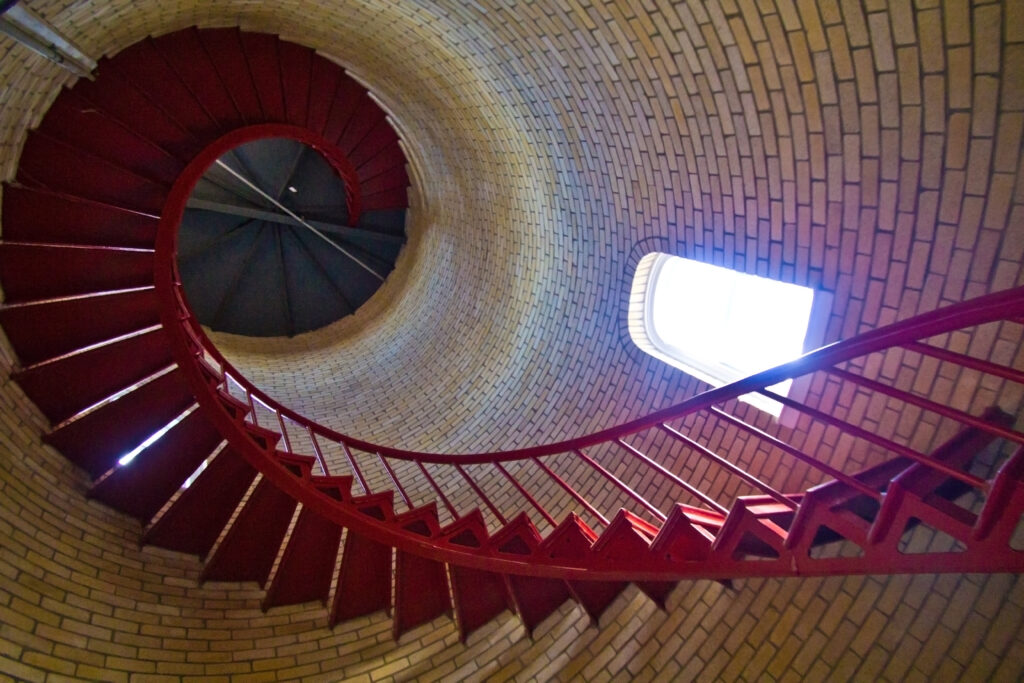
JEREMY
That is really great. About how many volunteers do you have, do you know?
BETSY RICHARDS
I have, and counting the board members and the other volunteers we have, approximately 20, and each year we usually are able to find two or three more who are interested. And the way it works, we always have at least two volunteers at any open house. One person stays at the base and one person goes up to the watch room and we kind of give different historic talks in the two places. And it works out very well because, especially in the summer, we even have three volunteers, sometimes two at the base, because we get just literally several hundred people. They get very upset if they can’t get up stairs right away. And so we kind of have to control the group and talk to different groups as before they can.
JEREMY
Yeah, well, thank you to you and all the volunteers to do that. It’s really a great thing. Do you know about how many visitors a year, an approximate number, that you get at the open houses?
BETSY RICHARDS
This past October — because we do this for the National Seashore, we have to report to them a variety of things about the lighthouse operation during the year. And last year from October to October, it was approximately 7,000 visitors. A number of those are school groups or outside groups who contact us. And we also have weddings there sometimes, and a variety of special groups come from near and far. We have people coming from all over the world and it’s a lot of fun to ask them where they come from, if you don’t know from their accent. And they often have great stories to tell about lighthouses where they come from, too.
JEREMY
I’ll bet. And from many other countries, I’m sure, as well all over the world. Yeah. Now I understand you also have something called a full moon tour in the fall.
BETSY RICHARDS
Yes. Every October on the day of the full moon, we have an evening open house from 6:30 to 8:30. This year it will be on Sunday, October 13th. And so far, since we’ve had this full moon tour for some five, six years, perhaps more, we have not really had to cancel because of rain. We don’t guarantees that you’ll see the moon. It might be cloudy, but we’ve been very fortunate. And when that full moon comes out over the lighthouse and you have a big gathering of people there, it’s very spectacular.
JEREMY
I’ll bet it is. I just want to go back over a little history quickly. Of course there were originally three lighthouses in Eastham established in 1838. It was the only place in the United States where three lights were established, originally, to differentiate the station from the single light in North Truro and the double lights down the coast at Chatham. The three small lighthouses were nicknamed the Three Sisters of Nauset. And the original towers were replaced by new ones in 1892. And the 1892 Three Sisters were eventually sold into private ownership and were later bought back by the National Park Service. They were restored and they’re now in a site on Cable Road, which is a short walk on a trail from Nauset Lighthouse And there are volunteer National Park Service guides. So I do want to point out that there’s really a lot for lighthouse buffs to see when they visit Nauset Light. I don’t know if either of you want to make any further comment on that, but it’s really a great lighthouse site because you get four lighthouses for your buck when you visit.
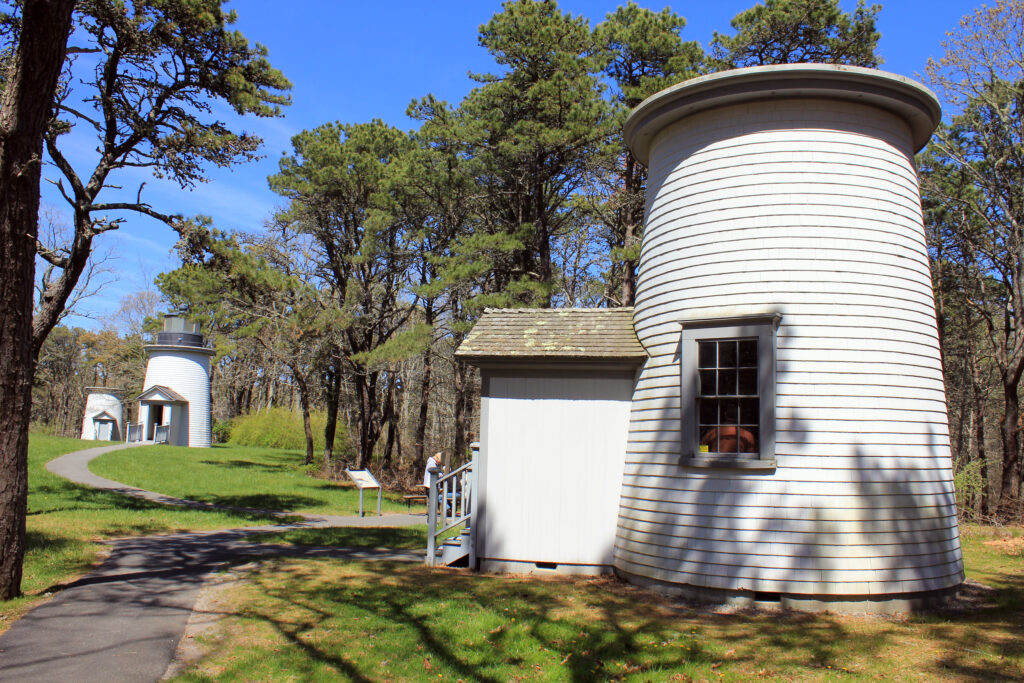
HAWKINS CONRAD
I might say — for your buck — we don’t charge you anything.
JEREMY
Right. For your no buck.
HAWKINS CONRAD
Well, the people who come to the lighthouse come for a variety of reasons. Some just out of curiosity because they’ve never been to a lighthouse before. And then the kids are just coming up from the beach. And so they’ll stop by. Those people have a rather shallow expectation of a lighthouse. And then you’ve got the diehard lighthouse buffs that come around and they’ll question you for hours if you let them, about all the aspects of the lighthouse. So we figure that people’s expectations when they come are so varied, and also is a nice thing for somebody to have something on Cape Cod that doesn’t cost them anything.
JEREMY
Right. Now, you don’t charge anything, but is there a way people can make donations when they visit? I assume there’s some sort of mechanism for that. I’m sure you welcome donations if people want to throw a dollar, or maybe even more than that, into a —
HAWKINS CONRAD
People are very generous. I think we probably do better by not charging than we would if we charged them something.
JEREMY
And maybe there’s a way through your website. Do you have memberships in your organization?
BETSY RICHARDS
Oh yeah. You can access all the information through nausetlight.org. You can get to memberships, you can get to our Facebook, our history — just about anything you’d like to know. Another thing that I would add about our tours, not only do we not charge, but there is no height limitation. I know at some lighthouses, you have to be a certain height, I guess for safety reasons, in order to climb. But we don’t have that limitation here.
JEREMY
I do want to mention also when people are in the area they can visit the Cape Cod National Seashore Salt Pond Visitor Center on Route Six in Eastham. There’s a lot of great exhibits in there, including the old fourth-order Fresnel lens from Nauset Light. There’s also a nice nature trail. People can walk around there on a nice day.
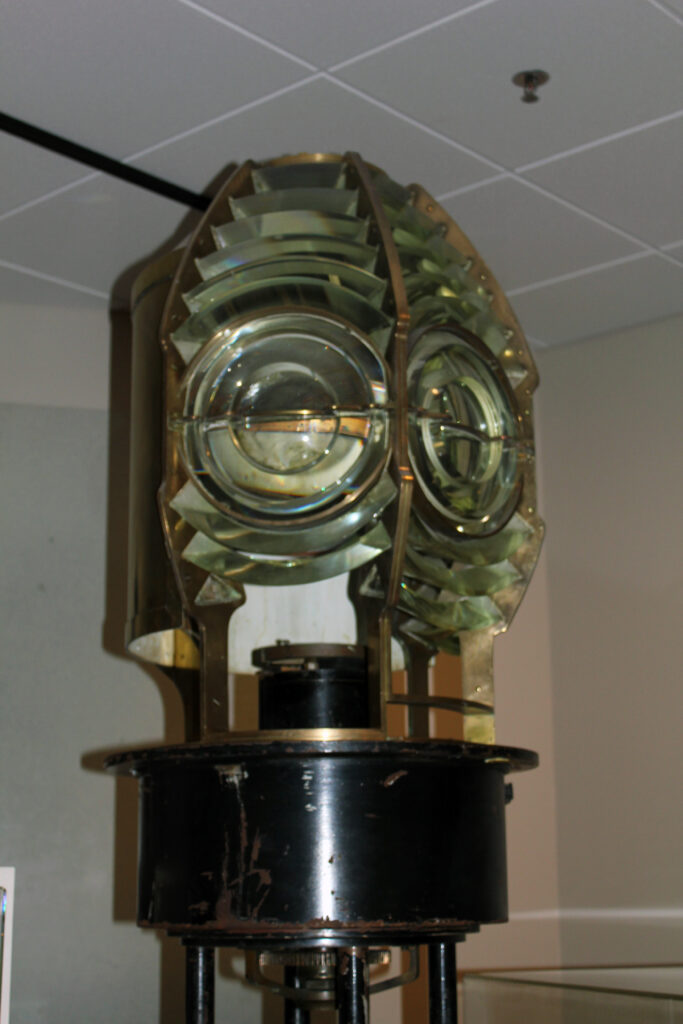
Well, thank you so much, Betsy Richards and Hawkins Conrad, for spending time with me today. Nauset Light is a beautiful and historic lighthouse. It’s a gorgeous area here on Cape Cod. And again, thank you so much.
MUSIC
MICHELLE
Now it’s time for our lighthouse history segment. Last time we went over the first couple of years of the history of the first lighthouse in the British colonies in North America, Boston Light.
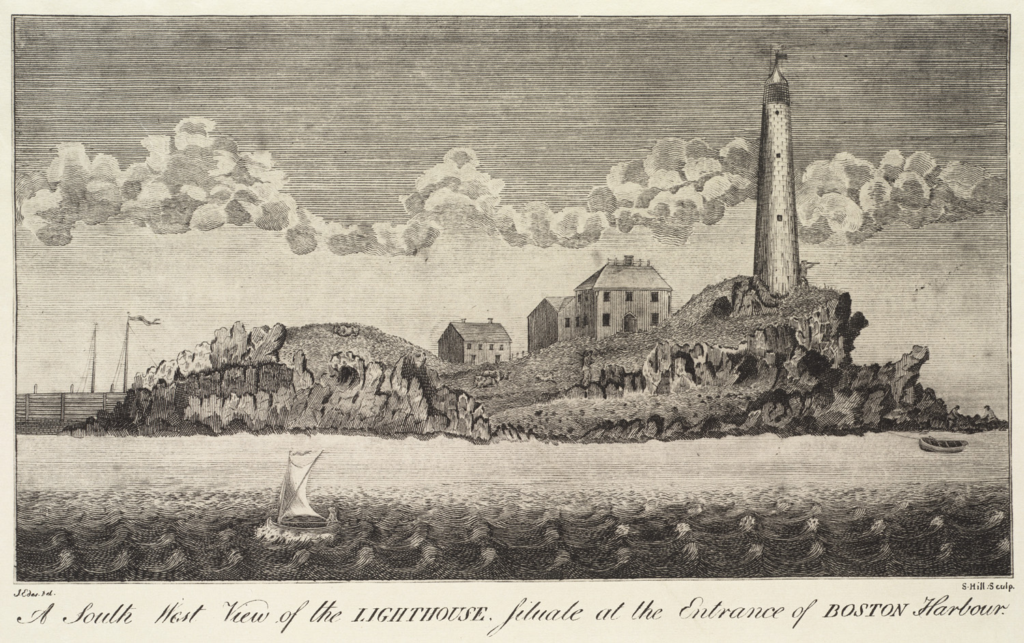
JEREMY
That’s right. And we’re going to pick up where we left off. We told you how the first two keepers of Boston Light, George Worthylake and Robert Saunders, both drowned in 1718. The next keeper, John Hayes, took over at a meager salary of 50 pounds a year in 1718. His pay would be raised to 85 pounds by 1720.
MICHELLE
In 1719, Hayes noted the need for some kind of fog signal. He asked that “a great gun may be placed on the said island to answer ships in a fog.” End quote. A cannon, America’s first fog signal, was placed on the island in 1719. Passing ships would fire their cannons when passing nearby in times of fog and the keeper would reply with a blast from the light station.
JEREMY
The cannon served on little Brewster Island for 132 years. In 1962, it was moved to the Coast Guard Academy in New London, Connecticut. In 1993, it was returned by helicopter to Little Brewster Island. And the venerable fog cannon, the first fog signal on the North American continent, is displayed today on a new carriage inside the entryway to the lighthouse tower.
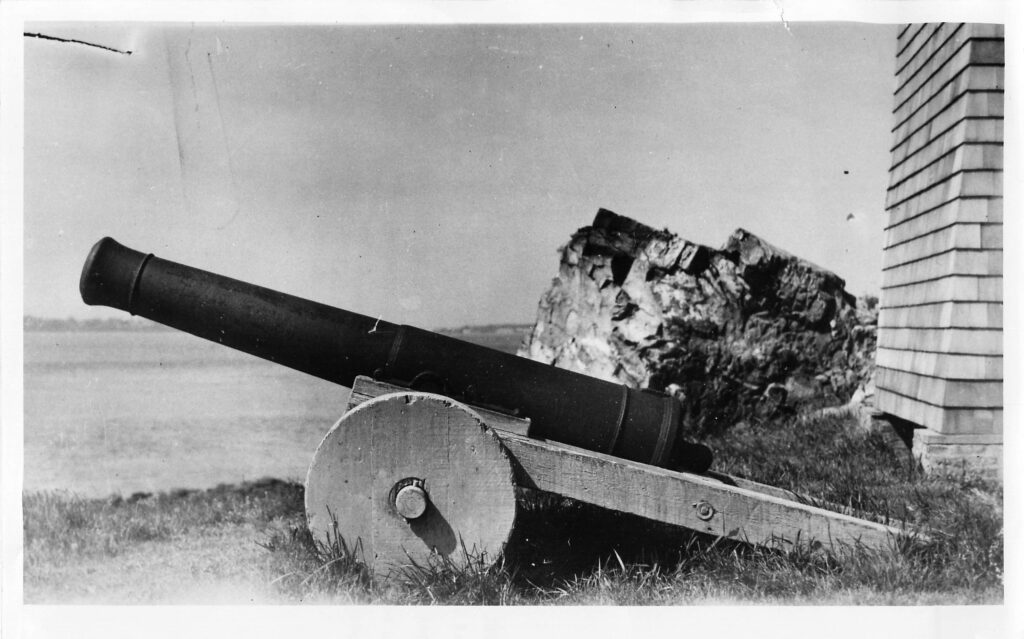
MICHELLE
The lighthouse was struck by lightning on several occasions in its early history, including an instance in June 1754 when lightning tore off shingles from the tower. The installation of a lightning rod was delayed because of the objections of some people who thought it, and I quote, “vanity and irreligion to presume to avert the stroke of heaven,” end quote. Practicality eventually won out and a lightning conductor was installed.
JEREMY
In July 1775, Boston Harbor and the lighthouse were under the control of the British. On July 20, American troops landed at the lighthouse and took lamps, oil, and some gunpowder and burned the wooden parts of the tower. After leaving the island, they had to outrun an armed British schooner, and two Americans were wounded. An eyewitness described “the flames of the lighthouse, ascending up to heaven like grateful incense, and the ships wasting their powder.”
MICHELLE
As the British worked to repair the tower, 300 American soldiers landed on the island on July 31st. They easily defeated the British guard and again burned the lighthouse. As they tried to leave, they found their boat stranded as the tide had gone out. This gave British vessels time to reach the scene. The Americans finally managed to launch their boats as the British fired upon then.
JEREMY
American troops at Nantasket in Hull helped by firing a cannon, landing a direct hit on one of the British vessels. This turned the tide of battle, and the Americans escaped with only one soldier having been killed. General George Washington praised the men for their “gallant and soldier-like behavior.” Then, at the end of their occupation of Boston Harbor during the war, the British lingered in the harbor for some months.
MICHELLE
On June 13th, 1776, a British boat went ashore at little Brewster Island. The soldiers set a timed charge that blew up the lighthouse. The remains of the metal lantern were reportedly used to make ladles for American cannons. It has also been claimed that part of the original tower was incorporated into the second one. Recent restoration has shown that the stones in the lowest part of the tower are different from the upper part. So it’s very possible that the bottom part does survive from 1716.
JEREMY
The Boston Light we know today was built in 1783 with a 15-foot brick addition added in 1859. So even though it’s the oldest light station in America, the lighthouse that stands today is the second oldest standing lighthouse tower in the country. The oldest is Sandy Hook Lighthouse in New Jersey at the entrance to New York Harbor. Sandy Hook Lighthouse was built in 1764. In the next edition of Light Hearted we’ll discuss the various kinds of apparatus and illuminants that were used before the important invention of the Fresnel lens. It’s time now for a trivia question. As always, it helps if you’ve listened to all of today’s edition of Light Hearted. What is today’s question, Michelle?
NOTE: THIS TRIVIA CONTEST IS CLOSED
MICHELLE
Name two lighthouses on Cape Cod that have been moved by the International Chimney Corporation. Again, name two lighthouses on Cape Cod that have been moved by the International Chimney Corporation. The first person to answer correctly gets a copy of the book Lighthouses of America, published in association with the U.S. Lighthouse Society. It’s a beautiful 176 page hardcover book featuring stunning photographs of lighthouses across the country, taken by Society photographers. The second person to answer correctly gets an official U.S. Lighthouse Society passport. The lighthouse passport program provides enthusiasts with the opportunity to help preserve lighthouses as well as a wonderful way to keep a pictorial history of their lighthouse adventures. You can learn more about the passport program at uslhs.org.
JEREMY
To enter, send your answer in an email to me at jeremy@uslhs.org. Be sure to say you’re answering the trivia question in Light Hearted episode 12. And again, send it in an email to jeremy@uslhs.org. That’s J E R E M Y at U S L H S dot O R G. And again, the first two people to answer correctly will win prizes. That wraps up this edition of Light Hearted. We’ll be back with one more edition later this week for Cape Cod week. So be sure to listen for that,
MICHELLE
Be sure to check out the U.S. Lighthouse Society website at uslhs.org for information on memberships and tours and lots of other interesting things. Also check out the USLHS news blog at news.uslhs.org, which includes the lighthouse news of the week on Fridays and other original content. There are also the USLHS social media pages on Facebook, Instagram, and Twitter.
JEREMY
And many thanks as always to the volunteers and staff of the USLHS at Point No Point in Washington and around the United States. Of course, thanks to our guests, Betsy Richards and Hawkins Conrad of the Nauset Light Preservation Society. You can check them out online at nausetlight.org. And thank you so much to my cohost, Michelle Jewell Shaw.
MICHELLE
Thanks Jeremy. Until next time —
JEREMY
Keep a good light.
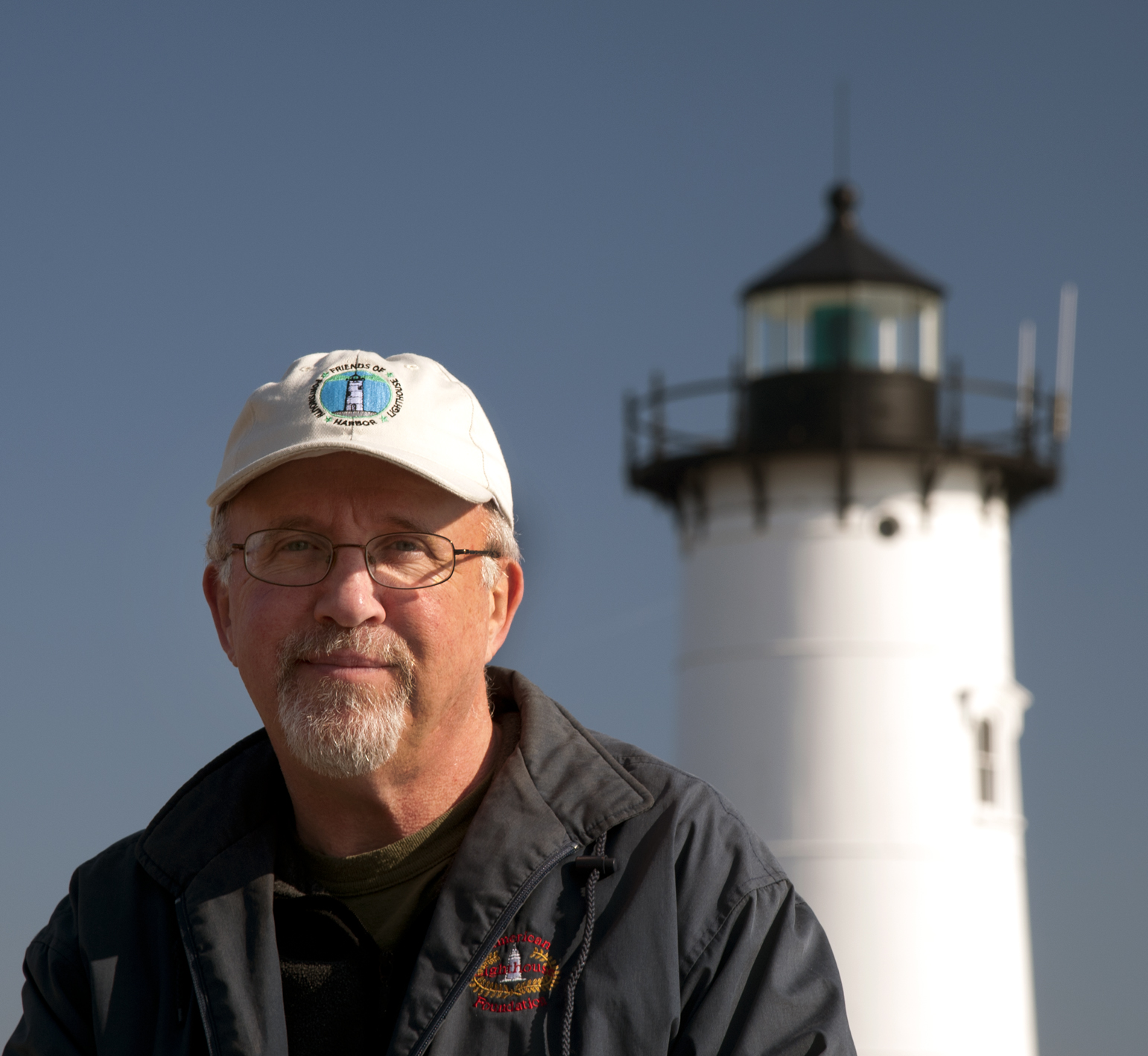
Jeremy D’Entremont is the author of more than 20 books and hundreds of articles on lighthouses and maritime history. He is the president and historian for the American Lighthouse Foundation and founder of Friends of Portsmouth Harbor Lighthouses, and he has lectured and narrated cruises throughout the Northeast and in other regions. He is also the producer and host of the U.S. Lighthouse Society podcast, “Light Hearted.” He can be emailed at Jeremy@uslhs.org

